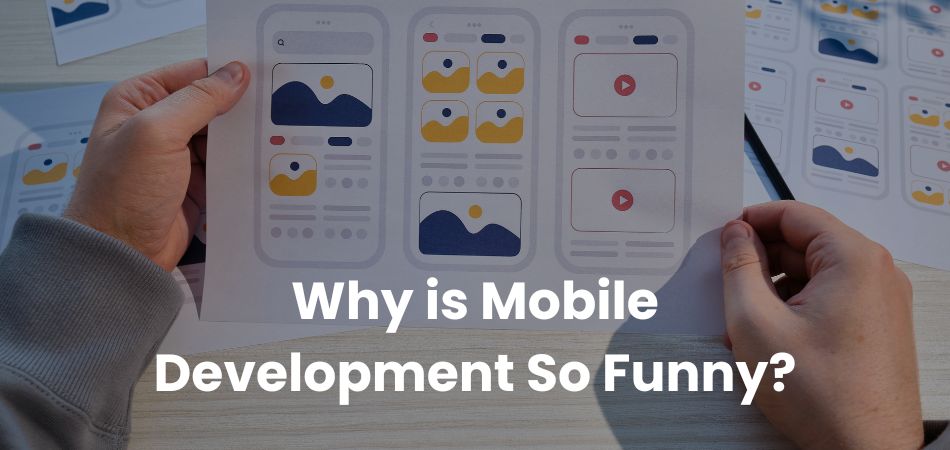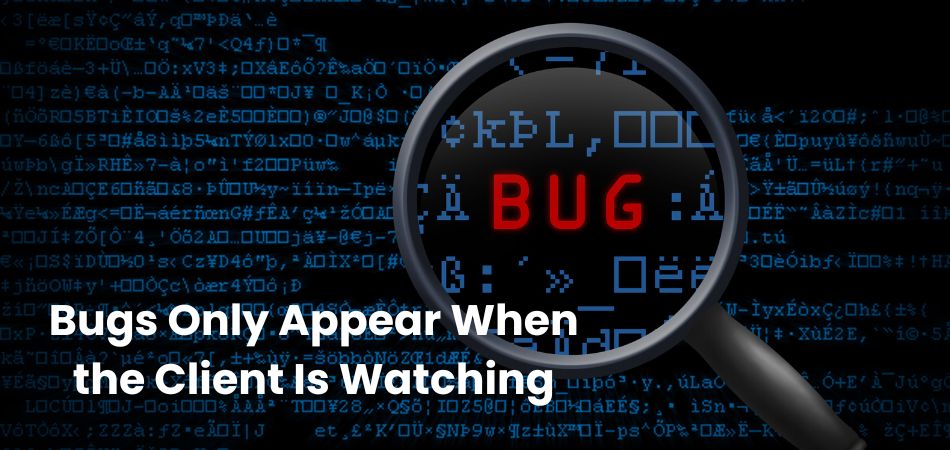Mobile development is a world full of quirks, unexpected bugs, and head-scratching moments. Whether you’re a seasoned developer or just starting out, you’ve likely encountered scenarios that are hilarious and frustrating.
From code that works perfectly on the emulator but crashes spectacularly on a real device to UI layouts that mysteriously shift between screens, the challenges often bring a smile—or a groan—to your face. So, why is mobile development so funny?
Mobile development is funny because it’s full of surprises: emulators lie, UIs shift, platforms feud, bugs appear at the worst times, and fixes often break more things than they solve.
Throughout this write-up, we’ll explore the comedic side of mobile development and celebrate the laughable moments that every developer knows all too well.
What Makes Mobile Development So Unpredictably Hilarious?
Mobile development is full of unexpected twists that make it both challenging and unintentionally hilarious. One minute your app is running perfectly on an emulator, and the next, it’s crashing on a real device for no apparent reason. These unpredictable behaviors often feel like a practical joke, leaving developers scratching their heads and laughing nervously as they hunt down the root cause.

Part of the hilarity comes from platform-specific quirks and inconsistencies. For instance, an app that looks flawless on an iPhone might render like a jumbled mess on an Android device—and vice versa. It’s almost as if different operating systems have their own sense of humor, introducing bugs and glitches at the most inconvenient times.
What makes mobile development so unpredictably hilarious is the sheer absurdity of the process. From mysterious crashes to UI layouts that shift out of nowhere, the chaos keeps developers on their toes while delivering moments of comedic relief.
Why is Mobile Development So Funny?
Mobile development is a challenging process filled with unexpected glitches, bizarre bugs, and moments straight out of a comedy sketch. It’s the kind of work where things that should make sense often don’t, and the smallest changes can wreak havoc on your app. Here are some of the most comical aspects of mobile development that leave developers laughing-or crying.

1. When the Emulator Says “Yes,” but the Device Says “No”
Developers often test their apps on emulators, only to find everything works perfectly. But when they switch to a real device, the app crashes, freezes, or behaves like it’s possessed. It’s as if the emulator and the device live in parallel universes with completely different rules. This mismatch can feel frustrating, but it’s also hilariously absurd—like a prank you never saw coming.
2. The Mysterious Case of the Shifting UI
Have you ever perfected your app’s UI layout, only to find it looks completely different on another screen size? Buttons disappear, text overlaps, and elements seem to have minds of their own. Auto-layout tools, meant to simplify the process, sometimes behave unpredictably, leading to laughably awkward interfaces. It’s like a game where your designs look beautiful everywhere—except where they need to.
3. The Battle of Platforms (iOS vs. Android)
Developing for both iOS and Android often feels like managing two feuding siblings. What works flawlessly on one platform can break spectacularly on the other. Each system has its own quirks, APIs, and behaviors, making cross-platform development both a challenge and a comedy. Developers are left wondering why platforms can’t just “get along” and behave consistently.
4. The Bug That Appears Only When You’re Demoing
There’s nothing funnier—or more painful—than a bug that shows up at the worst possible time, like during a live demo or presentation. It worked perfectly moments ago, but now your app refuses to cooperate. This kind of comedic timing feels almost deliberate, as if the app is trying to embarrass you in front of everyone. All you can do is laugh nervously and hope the audience sympathizes.
5. Auto-Correct and User Input Disasters
Mobile keyboards and auto-correct features have a way of sabotaging user inputs in hilarious ways. Whether it’s misspelled search terms, emoji overuse, or inputs causing crashes, developers often find themselves fixing issues they never anticipated. Sometimes the errors are so absurd that they make you pause and laugh before debugging. It’s a reminder that user input is one of the most unpredictable—and entertaining—parts of mobile apps.
6. The Infinite Loop of App Store Rejections
Submitting an app to the App Store or Google Play can feel like an endless comedy sketch. You fix one issue, only to get another rejection for something minor or unclear. Each rejection email reads like a riddle, and resolving the problem can take days of trial and error. It’s a process that’s both infuriating and oddly humorous as you try to decipher the hidden rules.
7. Updates That Break More Than They Fix
Pushing updates is meant to improve the app, but sometimes they introduce even stranger bugs. Users complain about features that used to work perfectly, and developers scramble to patch the patch. It’s an ongoing cycle that can feel like a comedy of errors, where every “fix” opens up a new can of worms. At the end of the day, you just have to laugh and promise users it’ll be better next time.
How Can One Bug Turn Into a Comedy Show?
Bugs in mobile development often start as small, seemingly harmless issues but can quickly escalate into full-blown comedy shows. It might begin with a button that doesn’t respond or a text field that refuses input. But as you dig deeper, the bug takes on a life of its own, triggering bizarre behaviors like endless pop-ups, app crashes, or UI elements that dance across the screen.
Suddenly, what started as a minor annoyance has you laughing at the sheer absurdity of it all. The real comedy emerges during the debugging process. You try fixing the issue, only to discover that your “solution” breaks something else entirely.
For example, a misplaced semicolon might cause an entire page to disappear, or fixing a minor UI glitch accidentally shifts everything off-screen. It’s moments like these that highlight the hilarity of software development—where a single line of code can make or break your app.
At its core, debugging is like being part of an unpredictable sitcom where the punchline keeps changing. Each test run brings new surprises, leaving you alternating between frustration and uncontrollable laughter. While bugs can be infuriating, their unintentional humor often becomes the highlight of the development process, reminding developers not to take it all too seriously.
Why Do Bugs Only Appear When the Client Is Watching?
It’s a tale as old as time in mobile development: the app works flawlessly during internal testing but breaks spectacularly when the client is watching. These bugs seem to have perfect comedic timing, appearing only when the stakes are highest. Here we’ll explore the strange phenomenon and why this always happens when you least expect it.

Murphy’s Law of Mobile Development
Murphy’s Law states, “Anything that can go wrong, will go wrong”—and in development, it feels personal. Bugs remain mysteriously hidden during tests, only to surface during live client demos. It’s almost as if the app knows when it has an audience and decides to misbehave for dramatic effect.
The “Untested Scenario” Dilemma
Clients often navigate apps in ways developers never imagined during testing. They click buttons you didn’t expect, enter strange inputs, or open screens in a weird sequence. This “untested scenario” triggers hidden bugs, making it seem like the app is waiting to embarrass you.
The Stress-Induced Debugging Blindness
The pressure of a live demo can make even the simplest issues hard to spot. While you scramble to explain what went wrong, the bug mocks you by refusing to appear during post-demo testing. Stress amplifies the humor, turning a small glitch into an unforgettable (and cringe-worthy) moment.
Devices and Networks (The Unseen Culprits)
During demos, unexpected factors like poor internet connections, outdated devices, or hardware quirks can wreak havoc on your app. These external elements create bugs that never appeared in your test environment. Watching your app crash because of something beyond your control feels both maddening and oddly funny.
The Client’s Magical Bug-Finding Powers
Somehow, clients have a knack for finding the most elusive bugs with minimal effort. They stumble upon glitches you’ve never seen before, as if they possess a sixth sense for breaking apps. It’s an uncanny and comedic talent that keeps developers both amazed and slightly terrified.
How Do Developers Cope With the Humor of Debugging?
Debugging can be one of the most frustrating yet comically absurd parts of mobile development. From invisible bugs to errors caused by a single misplaced character, developers often find themselves in situations that border on the ridiculous. Here’s how developers accept the humor of debugging and keep their sanity intact.
- Laughing at the Absurdity: When a bug defies logic—like a button working on one screen but disappearing on another—developers often just laugh. Humor becomes a coping mechanism, turning frustration into a lighthearted reminder that technology doesn’t always make sense.
- Sharing the Pain With Memes: Developers take to online forums, Slack channels, or social media to share funny memes about their debugging struggles. These relatable jokes build a sense of camaraderie, proving that everyone deals with similarly ridiculous issues.
- Talking to Rubber Ducks: The “rubber duck debugging” technique involves explaining your problem out loud, often to an inanimate object. Hearing yourself speak the issue can reveal the solution—and at the very least, you’ll get a chuckle at the absurdity of talking to a toy.
- Celebrating Small Wins: Fixing a stubborn bug after hours of head-scratching feels like a major victory. Developers often celebrate these moments with virtual high-fives, snacks, or taking a well-deserved break to recharge.
- Acceptance of the “It Works… Don’t Ask Why” Mentality: Sometimes, a bug mysteriously fixes itself, and no one knows why. Instead of questioning it, developers laugh, shrug, and move on—because in the world of debugging, you take wins wherever you can find them.
FAQs About the Funny World of Mobile Development
Mobile development is full of quirks and surprises, leaving developers with plenty of questions—and amusing stories. Whether it’s unexpected bugs, strange user behaviors, or platform-specific challenges, there’s always something to learn (or laugh about). Here are some FAQs that dive into the lighter side of mobile development.
1. Why Do Apps Behave Differently on Various Devices?
Every device has its own combination of screen size, operating system version, and hardware quirks. These variations can cause apps to behave unpredictably, even when the code is identical. It’s like trying to fit one puzzle piece into multiple puzzles—it sometimes just doesn’t line up perfectly.
2. Why Do Users Find Issues That Developers Never Noticed?
Users approach apps in unpredictable ways, often clicking buttons or testing inputs developers didn’t anticipate. This creates edge cases that reveal bugs missed during development. Developers can only laugh (and cry) as they patch issues they never thought were possible.
3. Why Are Mobile App Crashes So Hard to Replicate?
Crashes often depend on specific conditions like device settings, OS versions, or background processes. If you’re unable to recreate these exact conditions, the bug stays hidden. It feels like the crash only happens when no one’s looking, making debugging a wild goose chase.
4. Why Does Mobile App Testing Take So Much Longer Than Expected?
Testing involves multiple devices, operating systems, and user scenarios, which multiplies the workload exponentially. A single fix might work on one phone but cause a new issue on another. This never-ending loop of testing keeps developers on their toes—and sometimes in stitches.
5. Why is Mobile Development Such a Rollercoaster of Emotions?
From moments of triumph when everything works to despair when it suddenly doesn’t, mobile development is a mix of highs and lows. The unpredictability of bugs and fixes adds an emotional twist to every project. Developers learn to accept the ride, laughing at the chaos and celebrating the victories.
Final Words
Mobile development is a unique blend of challenges, surprises, and humor that keeps developers on their toes. From bizarre bugs that appear only during live demos to UI glitches that seem to have a mind of their own, it’s a process filled with moments that are equal parts frustrating and hilarious.
So, why is mobile development so funny? It’s the unpredictability, the absurd quirks, and the ability to find laughter in situations that would otherwise drive anyone mad. Developers learn to deal with the chaos, turning every bug, crash, and fix into a story worth sharing—and laughing about.
